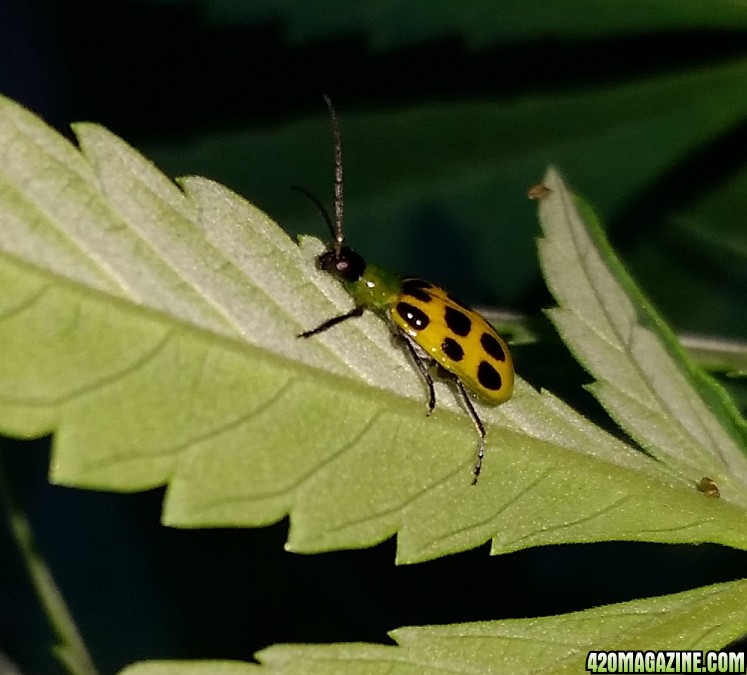Leaf chewers from your veggie gardens don't mind gnawing on your MJ plants if the opportunity is there. The four lined plant bug(described in a different post) is also considered a cucumber beetle by some.

I have a small cucumber and squash garden within a few feet of my outdoor plants this year. This beetle was doing some damage on the leaves.
Description
Cucumber beetles are found across the United States from Canada to Mexico and are either striped (Acalymma vittatum) or spotted (Diabrotica undecimpunctata howardi). Both species feed primarily on the leaves, flowers, and fruits of cucurbits (cucumbers, squash, pumpkins, and melons). Alternate plant hosts include beans, corn, peanuts and potatoes.
Adult cucumber beetles (1/4 inch long) are yellowish-green in color with dark heads, legs, and antennae. They have distinct black spots or lengthwise stripes on their wings. During the growing season, they are found feeding on seedlings, foliage, pollen and flowers, causing greatly reduced yields and sometimes plant loss. The slender, white larvae (up to 1/3 inch long), have brown ends and injure plants by feeding on roots and underground stems. Heavy larvae populations can reduce plant vigor and damage melon rinds, making the produce unfit for consumption or market.
Note: Adult and larval stages of the cucumber beetle transmit several plant diseases, including bacterial wilt and cucumber mosaic virus in cucurbits.
Life Cycle
Adult beetles overwinter in plant debris and garden trash. Females leave their winter sites in early spring and deposit up to 800 orange-yellow eggs in the soil near the base of plants. In about 10 days hatching occurs and the larvae feed for three or more weeks before pupating. First generation adults emerge 10 days later. A complete life cycle requires 6-9 weeks. Up to four generations can be produced in a single growing season.
Control
Select resistant varieties whenever possible.
Inspect plants frequently for beetles and handpick any that are discovered.
Floating row covers are extremely effective when placed on seedlings and left in place until plants are old enough to tolerate beetle damage.
Commercially available beneficial insects, such as ladybugs, green lacewing and the spined soldier bug, will feed on pest eggs.
Beneficial nematodes work well to curtail immature stages in the soil.
If pest levels become intolerable, spot treat with organic insecticides.
Remove garden trash and other debris shortly after harvest to reduce overwintering sites.
Tip: Securely fasten row cover edges to ensure that beetles do not find a place of entry.

I have a small cucumber and squash garden within a few feet of my outdoor plants this year. This beetle was doing some damage on the leaves.
Description
Cucumber beetles are found across the United States from Canada to Mexico and are either striped (Acalymma vittatum) or spotted (Diabrotica undecimpunctata howardi). Both species feed primarily on the leaves, flowers, and fruits of cucurbits (cucumbers, squash, pumpkins, and melons). Alternate plant hosts include beans, corn, peanuts and potatoes.
Adult cucumber beetles (1/4 inch long) are yellowish-green in color with dark heads, legs, and antennae. They have distinct black spots or lengthwise stripes on their wings. During the growing season, they are found feeding on seedlings, foliage, pollen and flowers, causing greatly reduced yields and sometimes plant loss. The slender, white larvae (up to 1/3 inch long), have brown ends and injure plants by feeding on roots and underground stems. Heavy larvae populations can reduce plant vigor and damage melon rinds, making the produce unfit for consumption or market.
Note: Adult and larval stages of the cucumber beetle transmit several plant diseases, including bacterial wilt and cucumber mosaic virus in cucurbits.
Life Cycle
Adult beetles overwinter in plant debris and garden trash. Females leave their winter sites in early spring and deposit up to 800 orange-yellow eggs in the soil near the base of plants. In about 10 days hatching occurs and the larvae feed for three or more weeks before pupating. First generation adults emerge 10 days later. A complete life cycle requires 6-9 weeks. Up to four generations can be produced in a single growing season.
Control
Select resistant varieties whenever possible.
Inspect plants frequently for beetles and handpick any that are discovered.
Floating row covers are extremely effective when placed on seedlings and left in place until plants are old enough to tolerate beetle damage.
Commercially available beneficial insects, such as ladybugs, green lacewing and the spined soldier bug, will feed on pest eggs.
Beneficial nematodes work well to curtail immature stages in the soil.
If pest levels become intolerable, spot treat with organic insecticides.
Remove garden trash and other debris shortly after harvest to reduce overwintering sites.
Tip: Securely fasten row cover edges to ensure that beetles do not find a place of entry.


